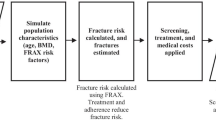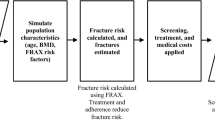Abstract
Summary
A state-transition microsimulation model was used to project the substantial economic burden to the Chinese healthcare system of osteoporosis-related fractures. Annual number and costs of osteoporosis-related fractures were estimated to double by 2035 and will increase to 5.99 (95 % CI 5.44, 6.55) million fractures costing $25.43 (95 % CI 23.92, 26.95) billion by 2050. Consequently, cost-effective intervention policies must urgently be identified in an attempt to minimize the impact of fractures.
Introduction
The aim of the study was to project the osteoporosis-related fractures and costs for the Chinese population aged ≥50 years from 2010 to 2050.
Methods
A state-transition microsimulation model was used to simulate the annual incident fractures and costs. The simulation was performed with a 1-year cycle length and from the Chinese healthcare system perspective. Incident fractures and annual costs were estimated from 100 unique patient populations for year 2010, by multiplying the age- and sex-specific annual fracture risks and costs of fracture by the corresponding population totals in each of the 100 categories. Projections for 2011–2050 were performed by multiplying the 2010 risks and costs of fracture by the respective annual population estimates. Costs were presented in 2013 US dollars.
Results
Approximately 2.33 (95 % CI 2.08, 2.58) million osteoporotic fractures were estimated to occur in 2010, costing $9.45 (95 % CI 8.78, 10.11) billion. Females sustained approximately three times more fractures than males, accounting for 76 % of the total costs from 1.85 (95 % CI 1.68, 2.01) million fractures. The annual number and costs of osteoporosis-related fractures were estimated to double by 2035 and will increase to 5.99 (95 % CI 5.44, 6.55) million fractures costing $25.43 (95 % CI 23.92, 26.95) billion by 2050.
Conclusions
Our study demonstrated that osteoporosis-related fractures cause a substantial economic burden which will markedly increase over the coming decades. Consequently, healthcare resource planning must consider these increasing costs, and cost-effective screening and intervention policies must urgently be identified in an attempt to minimize the impact of fractures on the health of the burgeoning population as well as the healthcare budget.



Similar content being viewed by others
References
Si L, Winzenberg TM, de Graaff B, Palmer AJ (2014) A systematic review and meta-analysis of utility-based quality of life for osteoporosis-related conditions. Osteoporos Int 25:1987–1997
Mithal A, Ebeling P, Kyer CS (2013) Asia-pacific regional audit: epidemiology, costs & burden of osteoporosis in 2013. International Osteoporosis Foundation, Nyon
Wang Y, Tao Y, Hyman ME, Li J, Chen Y (2009) Osteoporosis in China. Osteoporos Int 20:1651–1662
Kanis JA (2002) Diagnosis of osteoporosis and assessment of fracture risk. Lancet 359:1929–1936
Tian FM, Zhang L, Zhao HY, Liang CY, Zhang N, Song HP (2014) An increase in the incidence of hip fractures in Tangshan, China. Osteoporos Int 25:1321–1325
Johnell O, Kanis JA (2006) An estimate of the worldwide prevalence and disability associated with osteoporotic fractures. Osteoporos Int 17:1726–1733
Gullberg B, Johnell O, Kanis JA (1997) World-wide projections for hip fracture. Osteoporos Int 7:407–413
China Health Promotion Foundation (2008) White Paper China 2008, Osteoporosis a Summary Statement of China. Beijing
Ministry of Health (2010) China Health Yearbook. Beijing
Si L, Winzenberg TM, Jiang Q, Palmer AJ (2015) Screening for and treatment of osteoporosis: construction and validation of a state-transition microsimulation cost-effectiveness model. Osteoporosis international. doi:10.1007/s00198-014-2999-4
Zhang ZQ, Ho SC, Chen ZQ, Zhang CX, Chen YM (2014) Reference values of bone mineral density and prevalence of osteoporosis in Chinese adults. Osteoporos Int 25:497–507
Wang J, Wang Y, Liu WD, Wang F, Yin ZS (2014) Hip fractures in Hefei, China: the Hefei osteoporosis project. J Bone Miner Metab 32(2):206–214
Bow CH, Cheung E, Cheung CL et al (2012) Ethnic difference of clinical vertebral fracture risk. Osteoporos Int 23:879–885
Lofthus CM, Frihagen F, Meyer HE, Nordsletten L, Melhuus K, Falch JA (2008) Epidemiology of distal forearm fractures in Oslo, Norway. Osteoporos Int 19:781–786
(2013) China Statistical Yearbook 2013. National Bureau of Statiscitics of China, Beijing
Melton LJ 3rd, Thamer M, Ray NF, Chan JK, Chesnut CH 3rd, Einhorn TA, Johnston CC, Raisz LG, Silverman SL, Siris ES (1997) Fractures attributable to osteoporosis: report from the National Osteoporosis Foundation. J Bone Miner Res 12:16–23
Bliuc D, Nguyen ND, Milch VE, Nguyen TV, Eisman JA, Center JR (2009) Mortality risk associated with low-trauma osteoporotic fracture and subsequent fracture in men and women. JAMA 301:513–521
Wu M (2011) [Research on the development of nursing home care: demand and supply]. Shandong University
Qu B, Ma Y, Yan M, Wu HH, Fan L, Liao DF, Pan XM, Hong Z (2014) The economic burden of fracture patients with osteoporosis in western China. Osteoporos Int 25:1853–1860
LeBlanc ES, Hillier TA, Pedula KL et al (2011) Hip fracture and increased short-term but not long-term mortality in healthy older women. Arch Intern Med 171:1831–1837
Kanis JA, Brazier JE, Stevenson M, Calvert NW, Lloyd Jones M (2002) Treatment of established osteoporosis: a systematic review and cost-utility analysis. Health Technol Assess (Winchester, England) 6:1–146
Klotzbuecher CM, Ross PD, Landsman PB, Abbott TA 3rd, Berger M (2000) Patients with prior fractures have an increased risk of future fractures: a summary of the literature and statistical synthesis. J Bone Miner Res 15(4):721–739
Braithwaite RS, Col NF, Wong JB (2003) Estimating hip fracture morbidity, mortality and costs. J Am Geriatr Soc 51:364–370
Palmer AJ, Roze S, Valentine WJ, Minshall ME, Foos V, Lurati FM, Lammert M, Spinas GA (2004) Validation of the CORE Diabetes Model against epidemiological and clinical studies. Curr Med Res Opin 20(Suppl 1):S27–S40
Eddy DM, Schlessinger L (2003) Validation of the archimedes diabetes model. Diabetes Care 26(11):3102–3110
Hiligsmann M, Ethgen O, Bruyere O, Richy F, Gathon HJ, Reginster JY (2009) Development and validation of a Markov microsimulation model for the economic evaluation of treatments in osteoporosis. Value Health 12:687–696
Burge R, Dawson-Hughes B, Solomon DH, Wong JB, King A, Tosteson A (2007) Incidence and economic burden of osteoporosis-related fractures in the United States, 2005–2025. J Bone Miner Res 22:465–475
World Bank (2011) Population projection tables by country and group. The world bank group. http://data.worldbank.org/data-catalog/population-projection-tables Accessed 6 June 2014
Mithal A, Dhingra V, Lau E (2009) The Asian Audit Epidemiology, costs and burden of osteoporosis in Asia 2009. International Osteoporosis Foundation, Switzerland
Yan L, Zhou B, Prentice A, Wang X, Golden MH (1999) Epidemiological study of hip fracture in Shenyang, People’s Republic of China. Bone 24:151–155
Zhang L, Cheng A, Bai Z, Lu Y, Endo N, Dohmae Y, Takahashi HE (2000) Epidemiology of cervical and trochanteric fractures of the proximal femur in 1994 in Tangshan, China. J Bone Miner Metab 18:84–88
Brauer CA, Coca-Perraillon M, Cutler DM, Rosen AB (2009) Incidence and mortality of hip fractures in the United States. JAMA 302:1573–1579
Leslie WD, O’Donnell S, Jean S, Lagace C, Walsh P, Bancej C, Morin S, Hanley DA, Papaioannou A (2009) Trends in hip fracture rates in Canada. JAMA 302:883–889
Si L, Winzenberg TM, Palmer AJ (2014) A systematic review of models used in cost-effectiveness analyses of preventing osteoporotic fractures. Osteoporos Int 25:51–60
Schwenkglenks M, Lippuner K, Hauselmann HJ, Szucs TD (2005) A model of osteoporosis impact in Switzerland 2000–2020. Osteoporos Int 16:659–671
Burge RT, King AB, Balda E, Worley D (2003) Methodology for estimating current and future burden of osteoporosis in state populations: application to Florida in 2000 through 2025. Value Health 6:574–583
Lightwood J, Bibbins-Domingo K, Coxson P, Wang YC, Williams L, Goldman L (2009) Forecasting the future economic burden of current adolescent overweight: an estimate of the coronary heart disease policy model. Am J Public Health 99:2230–2237
Waldeyer R, Brinks R, Rathmann W, Giani G, Icks A (2013) Projection of the burden of type 2 diabetes mellitus in Germany: a demographic modelling approach to estimate the direct medical excess costs from 2010 to 2040. Diabet Med 30:999–1008
Honeycutt AA, Boyle JP, Broglio KR, Thompson TJ, Hoerger TJ, Geiss LS, Narayan KM (2003) A dynamic Markov model for forecasting diabetes prevalence in the United States through 2050. Health Care Manag Sci 6:155–164
Xu L, Lu A, Zhao X, Chen X, Cummings SR (1996) Very low rates of hip fracture in Beijing, People’s Republic of China the Beijing Osteoporosis Project. Am J Epidemiol 144:901–907
Johnell O, Kanis J (2005) Epidemiology of osteoporotic fractures. Osteoporos Int 16:S3–S7
Watts JJ, Abimanyi-Ochom J, Sander K (2013) Osteoporosis costing all Australians. A new burden of disease analysis–2012 to 2022. Osteoporosis Australia, Melbourne, Vic.
Acknowledgments
The study was orally presented at the International Osteoporosis Foundation (IOF) 5th Asia-Pacific Osteoporosis Meeting in Taipei, and the authors received IOF Young Investigator Award.
Conflicts of interest
None.
Author information
Authors and Affiliations
Corresponding author
Appendix
Appendix
Rights and permissions
About this article
Cite this article
Si, L., Winzenberg, T.M., Jiang, Q. et al. Projection of osteoporosis-related fractures and costs in China: 2010–2050. Osteoporos Int 26, 1929–1937 (2015). https://doi.org/10.1007/s00198-015-3093-2
Received:
Accepted:
Published:
Issue Date:
DOI: https://doi.org/10.1007/s00198-015-3093-2




